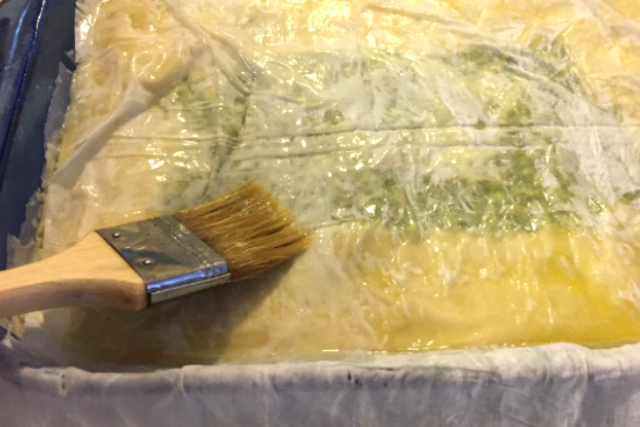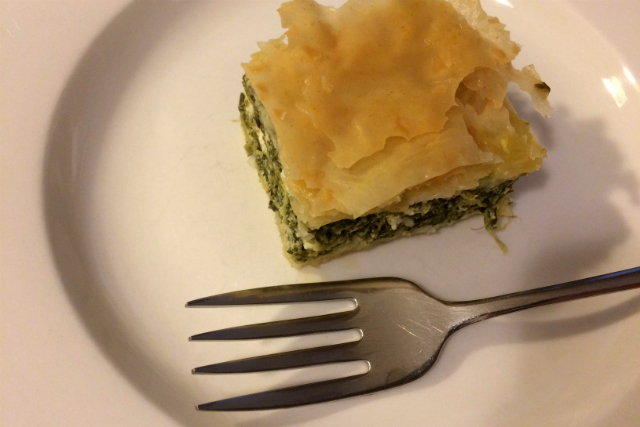Yiayia’s Spanakopita Adventure
Mom sent me on a mission as a kid. I was to watch Yiayia as she made spanakopita and find out how she did it. I’d like to say that I took detailed notes that afternoon and the experience launched my journalism career. That was not the case.
Yiayia worked deftly. The whole thing was a blur. She made spanakopita from memory so when she did remember to share measurements, they were estimates.
She also told me that when she was growing up in Greece, she made phyllo dough from scratch. Looking at the paper-thin dough, I couldn’t have been more surprised if she’d said she used to slay dragons.
Eventually my mom and I did get the recipe. I’ll never forget our first attempt. We huddled nervously over the phyllo dough. Even on a humid Vermont day, uncovered phyllo dries out and crumbles surprisingly fast. The end result, while good, didn’t taste exactly like Yiayia’s. Mom mused that maybe Yiayia’s ancient pastry brushes had something to do with it. Or just her touch.
What sets Yiayia’s spanakopita apart from other recipes is the delicate flavor. There is no onion or dill overpowering this Greek spinach pie. She used to say that she liked to leave chunks of feta so people would know what they’re eating.
Over the years, Mom and I have gotten much better at making spanakopita. At one point she tried swapping out the blended cottage cheese for light sour cream and it worked so well that we haven’t gone back. At altitude, I make it while racing against the dry air. For a half recipe, use an 8x8-inch glass pan and 4 eggs. It’s OK if they’re large.
Try to move quickly with the phyllo dough and be generous with the butter mixture. The sheets don’t have to be perfect. Really. Try to use the worst looking ones for the bottom if you can. Having someone re-covering the phyllo for you between layers can help, too.
Yiayia Danigelis’ Spanakopita
2 packages of frozen chopped spinach, 9 – 10 oz. each
8 small or 7 large eggs
1¼ C. (8 oz.) crumbled feta, leaving some chunks
1 C. nonfat sour cream (original recipe: 1 C. lowfat cottage cheese blended smooth in a blender)
½ tsp. sugar
1 Tbsp. lemon juice
1 Tbsp. flour mixed with ¼ C. whole milk in a lidded jar, shaken
¼ tsp. salt
1 lb. phyllo dough, 13 x 17 inches* (put it in the refrigerator the night before to thaw)
4 – 5 Tbsp. salted butter (original recipe: 1 stick unsalted butter, melted, and no olive oil)
4 – 5 Tbsp. olive oil
Preheat the oven to 375°F.
Microwave or heat spinach and press out as much liquid as you can. It should be very dry. Add it to a large mixing bowl, and stir in the salt, lemon juice, and sugar to cut the tartness. Shake the milk and flour in the jar well, and add it to spinach. Add the feta and blended cottage cheese or sour cream.
In a separate mixing bowl, beat the eggs until they’re thick and lemony looking and add those to the spinach mixture. Stir well. At this point you could cover the bowl and refrigerate the filling until the next day.
Get the phyllo dough ready. Use a flat cutting board at least the size of the phyllo. Make a plastic wrap cover for the phyllo, overlapping two long sheets. Take a clean dish towel and dampen it thoroughly with warm water. Wring it out and set it aside.
Cut off the top of the plastic sheath containing the phyllo and save all the packaging. With dry hands, unwrap the phyllo dough and unroll it onto the cutting board. Immediately cover it entirely with the plastic wrap so it doesn’t dry out. Put the damp towel over the plastic wrap. Avoid getting the dough wet from the towel. Avoid leaving any part uncovered.
Melt the butter in a small saucepan over low heat. Stir in an equal amount of olive oil. Once melted, turn off the heat and move the pan off the burner.
Here's a phyllo dough diagram for the next part:
Using a pastry brush — mine is a 2-inch natural bristle paintbrush — brush the bottom and sides of a 9x13-inch glass pan with the butter-oil mixture. Cover the bottom of the pan with overlapping phyllo sheets, brushing each sheet completely with the butter mixture. Get the edges as well. Repeat this with around 8 layers.
If the corners look thin, take little balls of phyllo and put one in each corner, buttering them well, to prevent the filling from leaking. Also look out for any bristles that might come loose and get into the pan.
Pour in the spinach filling, smoothing the top with a spatula. Shake the pan gently to settle it. Fold the phyllo edges down over the filling and brush them, too.
Place more sheets of phyllo on top, buttering each as you go. I like to fit these top layers over the top like pages in a book so one sheet becomes two neat layers (see right-hand image in the diagram). You’ll probably use at least three quarters of a pound for the whole dish.
Score the dough lengthwise along the top with a knife to make four long rows. Poke each scored strip with a fork a couple times to ventilate. Pour any remaining butter mixture over the top. (Re-roll and repackage any leftover dough, sealing the end with tape. Put it back in the box and re-freeze for future use.)
Wipe butter off the pan edges. Place the pan in the oven at 375°F and lower to 350°F. Bake for 1¼ hours for sea level, closer to 50 minutes at altitude. If the top is starting to get very brown, put foil over it with the shiny side up.
Test for doneness by inserting a knife. If the bottom seems hard then it’s done. Allow to cool before slicing and serving. It's best slightly warm.
*If you can only find the smaller size of phyllo dough, you can overlap the sheets. You may need more sheets on the bottom so it doesn't leak. Have extra melted butter and oil to coat the layers.



